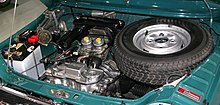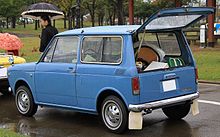Honda N360
| Honda N360/N600 | |
|---|---|
 1969 Honda N360 sedan | |
| Overview | |
| Manufacturer | Honda |
| Also called | Honda LN360 Honda NIII360 Honda N400 Honda LN400[1] Honda Scamp[2] Honda N600 Fu Gui (ROC)[3] |
| Production | 1967–1972 |
| Assembly |
|
| Body and chassis | |
| Class | Kei car/city car |
| Body style | 2-door sedan 3-door wagon ("Van") |
| Layout | FF layout [6] |
| Related | Honda Life Honda TN360 Honda Vamos Honda Z360/Z600 |
| Powertrain | |
| Engine | 354 cc N360E air-cooled SOHC I2 402 cc N400E I2 598 cc N600E I2 |
| Transmission | Four-speed manual constant mesh, dog-clutch engagement[7] |
| Dimensions | |
| Wheelbase | 2,000 mm (78.7 in) |
| Length | 2,995 mm (117.9 in) |
| Width | 1,295 mm (51 in)[7] |
| Height | 1,346 mm (53 in)[7] |
| Curb weight | 508 kg (1,119 lb)[7] |
| Chronology | |
| Successor | Honda Life (N360) Honda Civic (N600) |
The Honda N360 is a kei car, manufactured and marketed by Honda from March 1967 through 1970. After a January 1970 facelift, the N360 became the NIII360 and continued in production until June 1972.[8] A larger-engined variant, the N600, was marketed through 1973.
The two-door featured front wheel drive and an air-cooled, four stroke, 354 cc, 31 PS (23 kW) two-cylinder engine, which was derived from the one used on the Honda CB450 motorcycle. The displacement was reduced so as to comply with kei car legislation which stipulated maximum allowable engine displacement. This same engine was also used in the Honda Vamos, with a beam axle/leaf spring rear suspension. The "N" prefix stands for the Japanese word "norimono" which means "vehicle" in English — as distinct from Honda's motorcycle production. The exterior dimensions were in compliance with Japanese government regulations concerning kei cars, however, vehicles installed with the 401 cc and 598 cc engines were too large for the category, and were largely intended for international sales.
A modern revival was introduced in 2012 as the Honda N-One.
Versions
 1969 Honda N360 air-cooled engine |


A two-door sedan was the original body style, with a three-door wagon (considered a commercial vehicle in Japan, and therefore called a "Van") called the LN360 coming in June of the first year. It has a horizontally divided rear gate and boxier rear bodywork for maximum load capacity. The LN360 had the same 31 PS engine as the sedan, and a top speed of 105 km/h (65 mph). After a January 1970 facelift it became the LNIII 360, with a new non-reflective dash, bigger turn signals, and the same new front end as the sedan. The LNIII 360 was built until late 1971, when the Life Van took over.[9]
The N360 was an all new, clean-sheet product, and did not share its chassis with the Honda Sports roadster, or the Honda L700 commercial platform. An upgraded 36 PS (27 kW) engine was added in October 1968 for the N360 TS, which was sold as the N360 Touring following a minor update in January 1969. The updated version is referred to as the NII. A 401.54 cc engine was used in the similar N400, a model sold in certain export markets beginning in 1968. The engine's technological specifications reflected engineering efforts resulting from the development of the larger Honda 1300, which used an air-cooled 1.3 litre engine. One of the primary differences between the N360 and the Honda Life that followed was the N360/600 had an air-cooled engine, and the Life had a water-cooled engine. The water-cooled engine was better able to comply with newly enacted emission standards in Japan, and reflected an industry wide move away from air-cooled as well as two-stroke engines. As does the original Mini, but unlike the succeeding Life, the N360/600 had its gearbox mounted in the sump rather than bolted on as a separate unit.
The Hondamatic-equipped N360AT which appeared in August 1968 was the first kei car equipped with an automatic transmission.[10]
N600
The larger-engined N600 was developed alongside the N360 in order to target export markets like the US and Europe, where motorways demanded higher top speeds.[11] Just seven months after road testing the N360, Britain’s Motor magazine tested a Honda N600 in November 1968. They reported that it had a top speed of 77.1 mph (124.1 km/h) and could accelerate from 0-60 mph (97 km/h) in 19 seconds. An overall fuel consumption of 36.3 miles per imperial gallon (7.8 L/100 km; 30.2 mpg‑US) was achieved. The test car was priced in the UK at £589 including taxes, at a time when the Mini 850 was retailing for £561. The testers were impressed to find 1100 performance from a 600 cc car, but found it ‘very noisy when extended’. They found the Honda as easy to drive and park, and ‘quite well equipped’. The performance figures put the car at or near the top of its class under most criteria, reflecting its favourable power-to-weight ratio.[12] The car was thus 5 mph (8 km/h) faster than the 72 mph (116 km/h) achieved by rival magazine Autocar in an N360 in May 1968, and more than ten seconds quicker to 60 mph (97 km/h) which the N360 achieved in 29.3 seconds.[7] Consistent with its slower performance, the N360 squeezed 3 extra miles out of a (UK) gallon of fuel, managing an overall 39.4 miles per imperial gallon (7.17 L/100 km; 32.8 mpg‑US).[7]

The N600 was introduced to the USA in 1969 as a 1970 model, and was the first Honda automobile to be officially imported to the United States. It was technologically advanced for its time, with an all alloy engine that could achieve 9000 rpm. Engine output was 36–45 hp (27–34 kW) and the N600 was capable of 81 mph (130 km/h). The lower-powered engine arrived in 1972; with milder cams and lowered compression it gave up some peak power and torque, while allowing for a less peaky delivery and higher drivability.[13] It delivered surprisingly peppy performance because of its light weight (around 550 kg/1100 pounds), due to compact dimensions and some plastic parts (like the boot lid). The brakes on early models were very weak, despite having front discs and servo assistance. Rear suspension was a dead axle on leaf springs.

The N600 (along with the TN360 trucklet), were the first Honda cars to be assembled outside Japan, with production in Taiwan by local joint venture Sanyang Industrial beginning in 1969.[5] The N600 was called the Fu Gui, meaning 'Wealth' in Chinese (富貴).[3]
US sales stopped in 1972, as for the sportier Honda Z600 (or Z, depending on country), after about 25,000 had been sold there.[11] The first generation Honda Civic replaced these little cars with something a little more suited to the American Interstate highway network.
References
- ^ The LN360 and LN400, www.hondan600.com Retrieved on 4 March 2015
- ^ The Honda Scamp, www.hondan600.com Retrieved on 4 March 2015
- ^ a b The TN360 was called Fah Tsai Tser ('Rich Car', 發財車): "SYM History". Sanyang Industrial Co. Ltd. Archived from the original on 11 March 2013.
- ^ Leeps (4 June 1989). "Rust Busters". New Straits Times. Retrieved 24 May 2015.
- ^ a b "Honda Annual Report 2009: Corporate Information" (Document). Honda Motor Co. Ltd. p. 85Template:Inconsistent citations
{{cite document}}: Unknown parameter|accessdate=ignored (help); Unknown parameter|url=ignored (help)CS1 maint: postscript (link) - ^ Technical specifications, www.hondan600.com Retrieved on 4 March 2015
- ^ a b c d e f "Autotest:Honda N360". Autocar. Vol. 128 (nbr3768). 2 May 1968. pp. 44–47.
- ^ Koichi, Inouye (1985). World Class Cars Volume 2: Honda, from S600 to City (in Japanese). Tokyo: Hoikusha. p. 165. ISBN 4-586-53302-1.
- ^ 360cc 軽商用貨物自動車 1950-1975 (in Japanese). Tokyo: Yaesu Publishing. 2009. p. 97. ISBN 978-4-86144-139-4.
{{cite book}}: Unknown parameter|trans_title=ignored (|trans-title=suggested) (help) - ^ 360cc: Nippon 軽自動車 Memorial 1950→1975 (in Japanese). Tokyo: Yaesu Publishing. 2007. p. 69. ISBN 978-4-86144-083-0.
{{cite book}}: Unknown parameter|trans_title=ignored (|trans-title=suggested) (help) - ^ a b Display at the Twin Ring Motegi Honda Collection, available on Flickr
- ^ "Road Test Honda N600". Motor. November 1968. pp. 43–48.
- ^ Robinson, Peter, ed. (January 1973). "Four of the Tiddlers". Wheels. 38. Sydney, Australia: 40.
External links
- ThisOldHonda.org N360
- ThisOldHonda.org N600
- HondaN600.net
- Gainesville Sun May 7, 1982
- Ocala Star Banner October 7, 1982
- Sarasota Herald Tribune June 10, 1979
- The Honda N600E - The Little Car That Opened the Roadway in America
